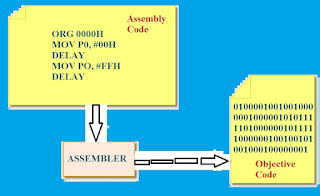What is an assemble language code?
We look at the inside of the 8051. We reveal some of the more used registers of the 8051 with easy command (instructions) such as MOV and ADD. We inspect assembly language and machine language coding and definition terms such as opcode, mnemonics, operand, etc. The process of collect and produce a ready to run code for the 8051.
 |
| 8051 Assembly language image-1 |
Step by step implementation of an 8051 and the part of the program counter are look into. We look at some interval between used assembly language pseudocode, directives, and data types connected to the 8051. We talk about the flag bits and how they are influenced by arithmetic command. Allotment of RAM memory core the 8051 plus the heap and roll banks of the 8051.
Registers
In the CPU, directories are used to store information for the moment. Those see to could be a byte of data to be processed, or a mark pointing to the data to be get. The huge seniority of 8051 registers are 8-bit registers.
In the 8051 there is only one data type: The eight (8) bits of a register are shown in the diagram from the MSB (most significant bit) D0. With an (eight) 8-bit data type, any data larger than (eight)8 bits must be splintered into (eight) 8-bit block before it is processed.
The accumulator, is used for all arithmetic and logic command register A. The most widely used index of the 8051 are (accumulator) A, B, R0, R1, R2, R3, R4, R5, R6, R7, (data pointer) DPTR and (program counter) PC (. To understand the use of these registers, we will show them in the conditions of two simple command, MOV and ADD.
Simply state, the MOV instruction copies data from one location to another location. It has the following format:
MOV destination, source ;copy source to destination.
This command tells the (in reality, copy) CPU to move the source operand to the landing place operand.
After this command is executed, register A will have the same value as register R0. The MOV command does not affect the source operand.